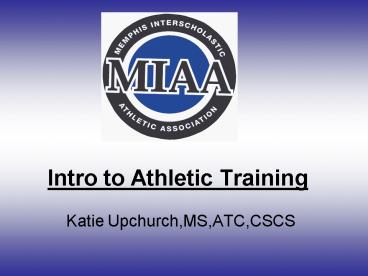Intro to Athletic Training - PowerPoint PPT Presentation
1 / 17
Title:
Intro to Athletic Training
Description:
Intro to Athletic Training. Katie Upchurch,MS,ATC,CSCS. What does an Athletic Trainer know? ... How to think on your feet!! What does an Athletic Trainer do? ... – PowerPoint PPT presentation
Number of Views:99
Avg rating:3.0/5.0
Title: Intro to Athletic Training
1
Intro to Athletic Training
- Katie Upchurch,MS,ATC,CSCS
2
What does an Athletic Trainer know?
- Prevention of injuries
- Evaluation of injuries
- First aid/emergency care
- Therapeutic modalities
- Therapeutic exercise
- Anatomy and physiology
- Nutrition
- Psychology
- How to think on your feet!!
3
What does an Athletic Trainer do?
- Takes care of injuries at games
- Teaches about hydration and nutrition
- Helps injured athletes get back to competition
through rehab and modalities - Tapes to prevent injuries
- Decides which injuries need further attention
from a doctor or other health professional - Game setup and breakdown
4
Where do Athletic Trainers work?
- As Instructors
- University
- High School
- Clinics
- Professional Sports
- Industrial/Work Place
- Physician Extender
5
Who are Athletic Trainers?
- Some former athletes
- All educational backgrounds arts,sciences,history
,psychology - Used to be mostly men, but has changed over to at
least 50/50 - All races and nationalities
- Very equal opportunity
6
What do you have to do to be an athletic trainer?
- Keep good grades
- Attend a college program where you can major in
athletic training OR - Get a college degree in whatever you want (health
sciences helps) and then get a two year Masters
degree in Athletic Training - Have good ethics and decision making skills
7
What are some of the perks?
- In a college or high school setting you get to be
on the field or court with the team - In college or pros you have opportunities to
travel and be on t.v. with the team (New Orleans
Bowl) - In clinics or as a physician extender you have
opportunities to work with doctors and physical
therapists - Get to help people!
8
What is your job as a student first responder?
- Game Setup-water, ice, emergency records
- Help With Taping
- Make Sure Athletes Stay Hydrated-timeouts,
sidelines, etc. - Observe Athletic Trainer in Injury Situations
- Confidentiality-no talking about injuries, when
in doubt DONT - YOU DO NOT TAKE THE PLACE OF A COACH OR ATHLETIC
TRAINER (no pressure)
9
What do you do for game setup?
- Make sure water coolers, ice chest, first aid
kit, and emergency contact information are on the
field - Make sure that there are cups or bottles so that
players can get water - Check the first aid kit to see if you need any
more supplies - Make sure your coach has their emergency contact
records - Check in with your athletic trainer if they are
there and see if they need any help with anything - Go through your checklist and see if there is
anything that you missed
10
What about during the game?
- Monitor water cooler to make sure there is plenty
of water for the rest of the game-if cooler is
low either fill it yourself or have someone help
you - Have your rubber gloves and first aid materials
ready in case someone has a cut that needs
wrapping - Watch the action in the game-if your athletic
trainer is there stay close to them, if an injury
happens follow what they tell you to do and watch
how they treat the injury - Feel free to ask questions! It is the best way to
learn.
11
How do you keep athletes hydrated?
- Keep water bottles or cups filled with water
during the game so that players can have it ready
for them - During timeouts or halftime you need to bring the
bottles/cups out to the players on the field - VERY important-especially during football season,
track, and baseball, but needed for ALL sports
12
Where do you go from here?
- We ask that you try to pick one sport per season
to try to be at most if not all of their home
games (for example football in the fall,
wrestling in the winter, and track in the spring) - If you do that coaches/players start to know who
you are and what you are there for - If you already know a coach ask to help with
their sport - We give you this information to help you give
back to your school
13
What about taping?
- We are going to teach you how to tape ankles
Step 1Place two anchor strips on the calf and
one around the foot near the arch.
14
Step 2 Apply one stirrup, pulling from the leg's
medial (inside) aspect, under the heel to the
leg's lateral (outside) aspect. Step 3 A
horizontal 'horseshoe' strip from the foot's
medial (inside) to lateral (outside) aspect is
then applied.
STEP 2
Step 3
15
The process is then repeated until there are
three stirrups and three horseshoes.
Close in ankle with horizontal closure strips
(just like horseshoes).
16
Two heel locks are then applied to the ankle's
medial (inside) and lateral (outside) aspects
17
Completed Closed Basket Weave Ankle Wrap































